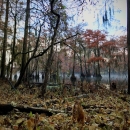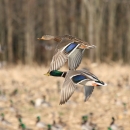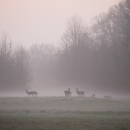About Us
The Red River National Wildlife Refuge (NWR) was created legislatively by the Red River National Wildlife Refuge Act - signed into law on October 13, 2000. The first land purchase was made in August 2002 consisting of 1,377 acres. According to legislation, the refuge shall consist of approximately 50,000 acres of Federal lands and waters along that section of the Red River between Colfax, Louisiana and the Arkansas state line, a distance of approximately 120 miles. Therefore, Red River NWR is comprised of a headquarters unit and four additional focus units. The purposes for which the refuge was established are as follows:
1. To provide for the restoration and conservation of native plants and animal communities on suitable sites in the Red River basin, including restoration of extirpated species;
2. To provide habitat for migratory birds; and
3. To provide technical assistance to private landowners in the restoration of their lands for the benefit of fish and wildlife (114 Stat. 1056, dated October 13, 2000).
Our Mission
The overarching mission for Red River NWR is to provide for the restoration and conservation of fish and wildlife habitats in the Red River Valley ecosystem in northwest Louisiana.
Our History
Red River NWR is located in the Red River Valley which historically was forested with bottomland hardwoods, cypress sloughs and shrub/scrub swamps, providing a variety of habitats for wildlife. In the early 1800’s, settlers began clearing land for homesteads and farms after the Louisiana Purchase. The mid-1800’s brought more clearing for cotton farming and during the mid-1900’s, deforestation accelerated with the increase in soybean prices.
In 1870, Captain Shreve began clearing log jams to make the Red River more navigable and attempts to improve navigation continued with the completion of the lock and dam system in 1994. Completion of the Red River Waterway Project in 1994 led to higher and more consistent water levels in the river which has greatly reduced the turbidity. Water quality has improved and with the seasonal retention of water levels, a rich diversity of aquatic plants has developed.
Increased water levels on the river also improved condiditons for some wildlife. Flooded timber and farm fields with wet, depressional areas are now more common and are being used by wading birds, waterfowl, and other aimals. USDA programs such as the Wetlands Reserve Program (WRP) and Conservation Reserve Program (CRP) are restoring valuable wildlife habitat through the reforestation of marginal farmlands and highly erodible lands in the Red River Valley.
Once the 50,000 acres has been acquired, the refuge will connect with other conservation areas reducing habitat fragmentation and providing wildlife corridors and stop-over areas for migrating waterfowl and songbirds.
Red River NWR is a relatively new refuge, therefore public use areas and opportunities are being added as staff and funding grow.
Other Facilities in this Complex
Red River NWR is part of the North Louisiana Refuges Complex. The Complex headquarters is located at D'Arbonne National Wildlife Refuge.



